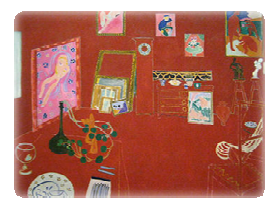Paintings’ Awakening, Karen David
[July 2, 2012]
Tom: I’m Tom.
Jerry: I’m Jerry.
Both: (gasp) You talk!
— Tom and Jerry: The Movie
Through observing the De Lacey family, the monster has become educated and self-aware. It had also discovered a lost satchel of books and learned to read. — Frankenstein by Mary Shelley
“Beep, Beep, Beep!” the microwave signalled the popcorn was ready, but Painting had already smelt the aroma as it wafted through the kitchen. Painting was rectangular in shape and lived in a constant state of flux. It was unsure of itself. While painting knew it existed, it did not know much more. Painting had no religion but it believed in belief as a tool and it was a curious soul.
Its curiosity led it down various avenues in it’s quest for enlightenment. Painting was well read in meditation, but couldn’t gain enlightenment even when facing a Rothko. It knew Caspar David Friedrich, but often felt more like the character in the Wanderer above the Sea of Fog (1818). It had heard rumours of Hilma af Klint and her trances that possessed her to make paintings, but it felt no such alignment. Once, on a trip to London, it happened upon Osman Spare and learnt of his sigils and automatic writings and wondered what or who was the ‘automatic’ force. It had read of Transpersonal Psychology and the work of Timothy Leary and Robert Anton Wilson and their research into the use of Psychotropic drugs to attain higher dimensions. It had also read that the use of Dimethyltryptamine (DMT) could induce symptoms that were associated with Near Death Experience or Alien Abductions, but alas Painting had its limitations and it was not able to induce a psychotropic state not matter how hard it tried.
It did, however, have a special fondness for Shirley Maclaine. As well as for her devout exploration of metaphysics, it had cried from start to end of Terms of Endearment (1983). And one day, while watching Postcards from the Edge (1990) Painting began to have its very own awakening.
It started out as any other film watching experience (sweet and salt popcorn, phone off the hook, curtains closed), but one scene in the film made Painting think in a way it had not thought before. The film Postcards from the Edge is a story of a movie star mother/daughter relationship. Painting liked this one in particular as it knew the story was written by movie star Carrie Fisher, who herself is a daughter to movie star Debbie Reynolds. Painting was excited about a fictional story, knowing it had parallels to real life, and he also enjoyed
watching films that were about films, but he did not yet know why.
In one scene daughter Meryl Streep is acting a role within a role of a policewoman hanging on by her fingers to the edge of a very tall building with her body dangling off the edge. Painting had seen this many times in other films where a character is holding on to the edge of a precipice; usually it is the villain who, on losing his grip, is saved by the hero from a plummeting death. Recognising this filmic trope, Painting also recognised his ability to read the language of film and it
was pleased by this.
However, in this instance, as Streep is being filmed within the film, she sighs in frustration and lifts her hands in exasperation. In this moment the camera pans out, revealing that the tall vertical building is actually a film set and set horizontally on the ground on which Streep is lying. This fascinated Painting for some time. “The film is a film within a film” thought Painting over and over. And began to think of itself in relation to thismeta relationship. A painting within a painting? It
thought of “The Red Studio” by Henri Matisse (1911).
Karen David 2012



[No Comments]